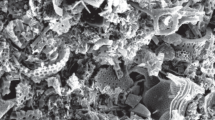Abstract
A study of the mechanism of wetting for spinneret materials by molten rocks of the basalt type is provided. A floating mechanism is described for a spinneret under the action of electrochemical transfer forces. The change in wetting angle under the action of electrochemical transfer forces is demonstrated.
Similar content being viewed by others
References
M. P. Alekseenko, Cohesion and Adhesion of Hot Glass [in Russian], Mashinostroenie, Moscow (1969).
Yu. K. Delimarskii, Electrochemistry of Ionic Melts [in Russian], Mashinostroenie, Moscow (1978).
Yu. K. Delimarskii, Theoretical Bases of Electrolysis of Ionic Melts [in Russian], Khimiya, Moscow (1986).
Author information
Authors and Affiliations
Additional information
__________
Translated from Novye Ogneupory, No. 2, pp. 43–46, February, 2007.
Rights and permissions
About this article
Cite this article
Novitskii, A.G., Efremov, M.V. Study of the flow mechanism for molten basalt over the surface of feeders made of high-temperature alloys. Refract Ind Ceram 48, 53–56 (2007). https://doi.org/10.1007/s11148-007-0026-4
Received:
Issue Date:
DOI: https://doi.org/10.1007/s11148-007-0026-4




